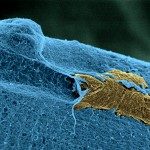Lien vers Pubmed [PMID] – 8416386
J. Virol. 1993 Jan;67(1):589-92
Theiler’s virus, a murine picornavirus, persists in the central nervous systems of susceptible mice and induces a chronic demyelinating disease. Susceptibility or resistance to this disease is controlled in part by the H2-D locus of the major histocompatibility complex (MHC). For this reason, it has been proposed that CD8+ class I-restricted cytotoxic T cells play a main role in the pathogenesis of this viral infection. We recently reported the existence of anti-virus CD8+ cytotoxic T cells in the course of Theiler’s virus infection. In the present study, we examined the role of these effector cells in mice in which the beta 2-microglobulin gene had been disrupted. These mice fail to express class I MHC molecules and therefore lack CD8+ T cells. The mice are derived from a C57BL/6 x 129/Ola cross and are H-2b, a haplotype associated with resistance to Theiler’s virus infection. beta 2-Microglobulin-deficient mice (beta 2m-/-mice) failed to clear the virus, developed demyelination, and, interestingly, did not succumb to early infection. These results demonstrate that CD8+ T cells are required to clear Theiler’s virus infection. In contrast with a current hypothesis, they also demonstrate that CD8+ T cells are not major mediators of the demyelinating disease.

